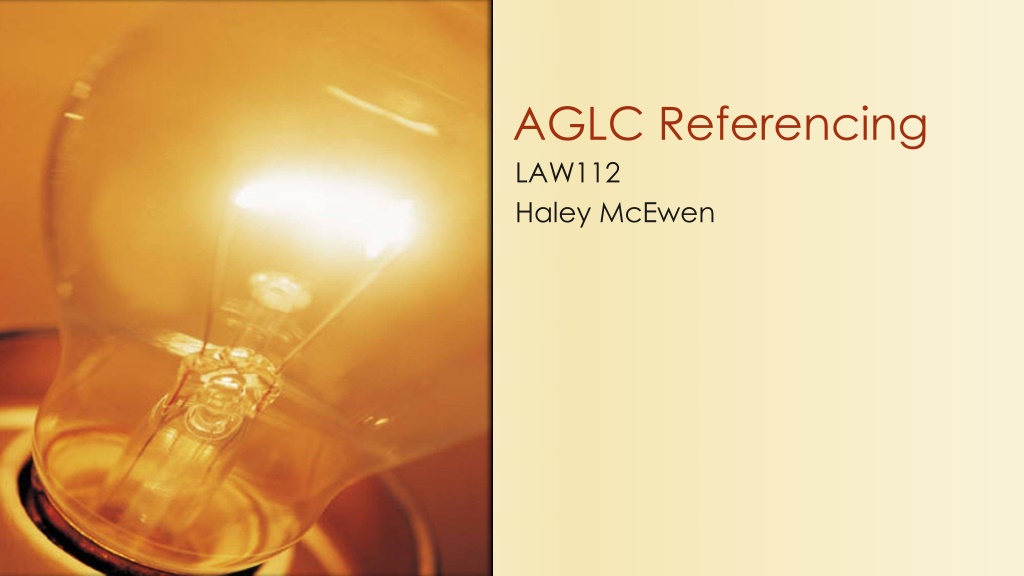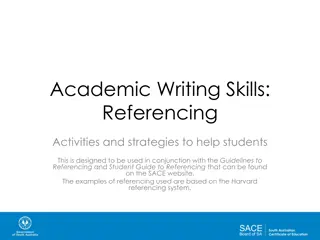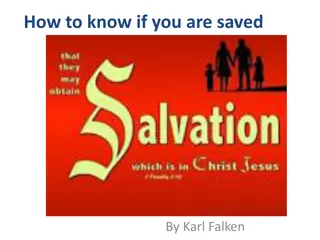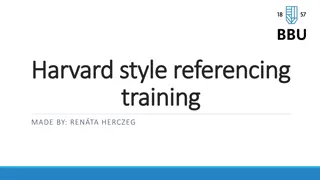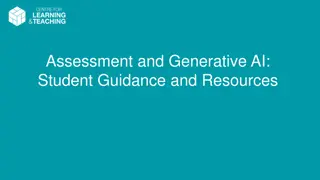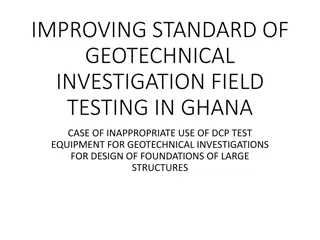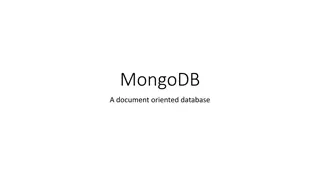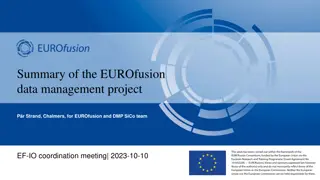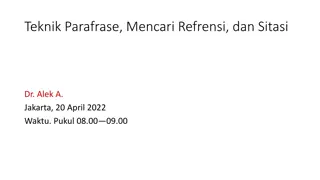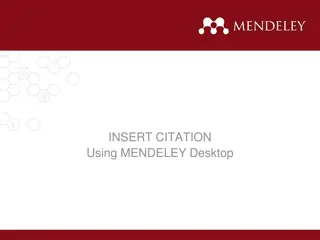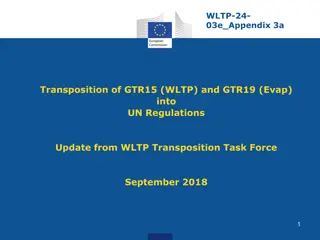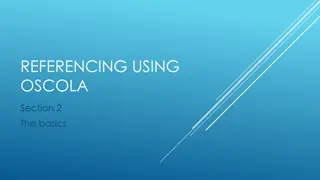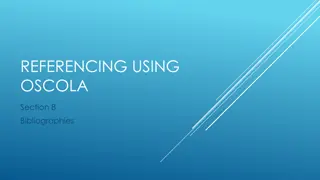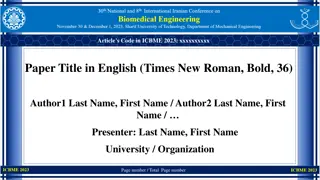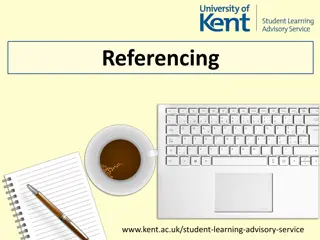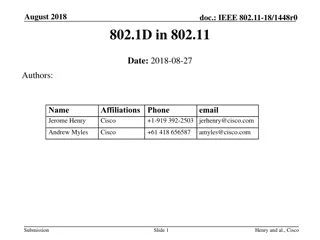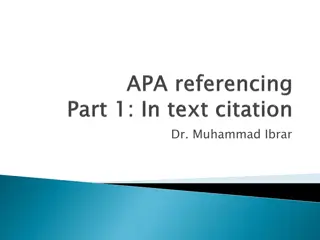AGLC Referencing
The Australian Guide to Legal Citation (AGLC) is a referencing style used to acknowledge sources in legal writing. It includes in-text reference numbers, footnotes, and a bibliography. Proper punctuation and citation are essential for clarity and credibility in academic writing. Footnotes are used to cite sources, provide additional information, and support arguments. Repeat citations can be made efficiently using terms like "ibid" and "above n." Case citations include party names and unique references for easy location.
Download Presentation

Please find below an Image/Link to download the presentation.
The content on the website is provided AS IS for your information and personal use only. It may not be sold, licensed, or shared on other websites without obtaining consent from the author.If you encounter any issues during the download, it is possible that the publisher has removed the file from their server.
You are allowed to download the files provided on this website for personal or commercial use, subject to the condition that they are used lawfully. All files are the property of their respective owners.
The content on the website is provided AS IS for your information and personal use only. It may not be sold, licensed, or shared on other websites without obtaining consent from the author.
E N D
Presentation Transcript
AGLC Referencing LAW112 Haley McEwen
Its not easy but you have the answers AGLC3 what is it? The Australian Guide to Legal Citation is a referencing style for legal citations that consists of: In-text reference numbers within the body of your assignment to acknowledge each source used, using a superscript (raised) number A list of footnotes at the bottom (foot) of each page, for all citations on that page, consecutively numbered A bibliography at the end of the paper which details each source mentioned in the text, as well as details of other sources consulted in preparing the paper
Why bother? It is easy to dismiss rules of punctuation and legal citation as the province of pedants and to imply that attention to such matters privileges style over substance. Punctuation, however, can be critical to meaning and clarity As for citation, scholars have a responsibility to acknowledge the sources of their information and ideas carefully so that they can be readily traced by their readers. (Hilary Charlesworth, Australian Guide to Legal Citation, 3rded, Melbourne University Law Review Inc., 2010)
Footnotes When do we use them? 1. Whenever you use someone else s ideas 2. When you refer to information from another source 3. To back up an argument 4. To provide extra information that is not appropriate to include in the body of the text. How? 1. Numbered consecutively. 2. Number should be placed at the end of the text to which the corresponding footnote refers. 3. Number should appear after any relevant punctuation (,/.).
Repeat citations The full bibliographic details should not be provided each time in a footnote The terms ibid and above n are used to refer to previous citations Ibid if it is the only source cited in the immediately preceding footnote Ibid + pinpoint ref to refer to the same source as in the immediately preceding footnote but to a different page or section Above n to refer to a source cited in a previous footnote other than the immediately preceding one Repeat citations of legislation and of cases: ibid but not above n
Cases Case citations include the party names and a unique reference which can locate the case Reported case citations Square brackets enclosing the year in the reported case citation indicates that the year of publication is the volume number Round brackets enclosing the year of publication indicate that the case can be found in the volume represented by the volume number in the citation. Koowarta v Bjelke-Peterson (1982) 153 CLR 168 Unreported judgments No page numbers, pinpoint references are managed by sequentially numbering all paragraphs in the online judgment Browne v Dunne [2000] HCA 23 at [4]
Legislation Statutes Trade Practices Act 1974 (Cth) s 52. Delegated legislation Criminal Procedure Regulations 2005 (WA) reg 6A. Gazettes Western Australia, Western Australian Government Gazette, No 30, 28 February 2014, 526. Bills Criminal Investigations (Identifying People) Amendment Bill 2012 (WA) cl 3. Explanatory Memoranda Explanatory Memorandum, Conservation and Land Management Amendment Bill 2002 (WA).
Books / E-books / looseleaf services Depends on number of authors Michael Tilbury et al, Remedies: Commentary and Materials (Thomson Reuters, 5thed, 2011) 701-11. Chapter or article in edited book Jeff Berryman and Robyn Carroll, 'Cy-pr s as a Class Action Remedy - Justly Maligned or Just Misunderstood?' in Kit Barker and Darryn Jensen (eds), Private Law: Key Encounters with Public Law (Cambridge University Press, 2013) 320-22. E-book cite as you would a print book Looseleaf service LexisNexis Butterworths, ABC of Evidence (at 12 August 2013) [400].
Journal articles Two authors, issue number, with pinpoint Simon Young and Sarah Murray, 'An Elegant Convergence? The Constitutional Entrenchment of Jurisdictional Error Review in Australia' (2011) 11(2) Oxford University Commonwealth Law Journal 117, 118. Online journal, more than two authors, issue number with pinpoint Sally Kift, Rachael Field and Ian Wells, 'Promoting Sustainable Professional Futures for Law Graduates through Curriculum Renewal in Legal Education: A Final Year Experience (FYE2)' (2008) 15(2) eLaw Journal: Murdoch University Electronic Journal of Law 145, 146 <http://elaw.murdoch.edu.au/archives/issues/2008/2/ elaw_15_2_Kift_Fieldz-Wells.pdf>.
Other secondary sources Law Reform Commission Reports Australian Law Reform Commission, For Your Information: Australian Privacy Law and Practice, Report No 108 (2008) vol 1, 259 [5.9]. Conference Papers Jenny Lin, 'Audits of Shareholder Panels' (Paper presented at the 17th Annual Congress of the World Auditors Association, Li, 12 April 1994).
Newspapers Signed with pinpoint Ellen Whinnet, 'Industry Poll Reserves Greens, Survey Forestry Offensive', The Mercury (Hobart), 25 September 2004, 3. Unsigned with pinpoint 'Little Corporate Appeal in Green Bottom Line', Business, The Age (Melbourne), 6 June 2005, 4. Online only (no page numbers) Farrah Tomazin, 'Kinder Wages Breakthrough', The Age (online), 19 May 2009 <http://www.theage.com/au/national/education/kinder -wages-breakthrough-20090519.bcwh.html>.
Dictionaries and encyclopaedias Legal dictionary: print / online General dictionary (online) For online include the date last updated or date accessed. The title of the dictionary entry is at the end in quotation marks. Eg. Susan Butler (ed), Macquarie Dictionary (online ed, at 24 April 2015) 'Specific'. Encyclopaedias Where a legal encyclopaedia is viewed online, the volume number is omitted. If the date of last update is indicated, this should be included in the footnote. Otherwise, the date of retrieval should be listed. Thomson Reuters, The Laws of Australia (at 23 May 2013) 21 Human Rights, '4 Civil and Political Rights' [21.4.180].
Websites Full date created: Use the year, month, and day of date created, if available International Whaling Commission, IWC Information (4 August 2010) <http://www.iwcoffice.org/commission.iwxmain.htm>. No date: Law Society of Western Australia, History of the Law Society of Western Australia, <http://www.lawsocietywa.asn.au/history>.
What if there is no rule? See page xiii of the guide: when there is no rule for a particular source in the AGLC, users should attempt to adapt the closest fitting rule . Find the reference type that most closely matches your source and adapt it according to the general AGLC rules, keeping in mind: Clarity and accuracy Consistency with other AGLC rules Pinpoint references should appear at the end of citations Aesthetic appeal.
Test your style! Q1 When there is a punctation mark in your text (e.g. comma, full stop, quotation mark), on which side of the punctuation mark will you place the footnote? The footnote reference number generally follows immediately after the punctuation mark.
Test your style! Q2 When we refer to legislationwhich needs to be sourced fully, where does the footnote appear? The footnote reference number follows immediately after the word, phrase or quotation to which it refers. Note that there is no space between the last letter and the footnote number.
Test your style! Q3 How is a short quotation of less than 3 lines incorporated into the text of the essay? It uses single quotation marks and flows with the text of the sentence.
Test your style! Q4 What rules govern the placement of long quotations (more than 3 lines) in the text of an essay? Long quotations are: indented to the right smaller font single spaced where the rest of your essay may be double spaced typically introduced with a colon (other options may apply) begin with a capital letter (other options may apply) do not use quotation marks for block quotations.
Test your style! Q5 How is the source cited for a long quotation from a statute? The full information for referencing the statute is in the text itself not in the footnote reference.
Test your style! Q6 List the corrections required for this reference. Terrorism (Police Powers) Act 2002 [NSW] S77 Correct reference: Terrorism (Police Powers) Act 2002 (NSW) s 77. Italicise the year of the Act. Put round brackets (not square) around the Australian jurisdiction. Refer to a section of legislation by using a lower case 's' followed by a space. Put a full stop at the end of the footnote reference.
Test your style! Q7 List the corrections required for this book citation: Cook, C., Creyke, R., Gesses, R., Hamer, D., & Taylor, T., Laying Down the Law (2015) (9.18). Correct reference: Catriona Cook et al, Laying Down the Law (LexisNexis, 9thed, 2015) [9.18]. Use authors' full names in preference to initials. Given names go before surnames, not after. More than 3 authors is referenced by the first full name only plus et al, Place a comma after the authors' names. Italicise the title of the book. Include publisher, print edition then year in brackets When the pinpoint reference is a numbered paragraph, it is placed in square brackets.
Test your style! Q9 In NSW, victims compensation is a civil remedy administered by the Department of Justice. Does this statement require a citation? Give a reason for your answer. No: this is common knowledge which may be found in any publication on victims services in NSW.
Test your style! Q10 In NSW, a focus on rehabilitation and support for victims of crime has meant that the resources available for financial assistance has declined. Does this statement require a citation? Give a reason for your answer. Yes: This text reflects an opinion. While that opinion seems to be a fair and just consideration of the issue, another writer may argue from a different position so it is important to back up your argument with evidence.
References Academic Skills Office, University of New England, Subject Specific Writing, https://tals.une.edu.au/ssw/law/workshops/topic3- intro.html. The University of Western Australia, AGLC referencing guide: Using AGLC, last updated 2 June 2017, http://guides.library.uwa.edu.au/c.php?g=325349&p=21 77482. Australian Guide to Legal Citation, 3rded, Melbourne University Law Review Inc., 2010 http://law.unimelb.edu.au/__data/assets/pdf_file/0007/1 586203/FinalOnlinePDF-2012Reprint.pdf.
